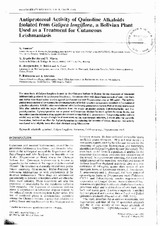Antiprotozoal activity of quinoline alkaloids isolated from Galipea longiflora, a Bolivian plant used as a treatment for cutaneous Leishmaniasis
Fecha
1994Autor
Fournet, A
Angelo Barrios, A
Muñoz, V
Hocquemiller, R
Roblot, F
Cavé, A
Richomme, P
Bruneton, J
Metadatos
Mostrar el registro completo del ítemResumen
Abstract.
The stem bark of Galipea longiflora is used by the Chimane Indians in Bolivia for the treatment of cutaneous leishmaniasis produced by Leishmania braziliensis. Petroleum ether and chloroform extracts of stem, root bark and leaves were found active in vitro against Leishmania ssp and Trypanosoma cruzi at 100 µg/mL. The activity guided fractionation of the extracts by chromatography afforded 12 active compounds identified as 2-substituted quinoline alkaloids. BALB/c mice were infected with Leishmania amazonensis (strain PH8 or H-142) and treated 24 h after infection with the major alkaloids from the crude alkaloidal extract; 2-phenylquinoline and 2-n-pentylquinoline. 2-phenylquinoline was as potent as Glucantime (Rhône-Poulenc) against the strain H-142, but less active than the reference drug against the virulent strain PH8 of L. amazonensis. 2-n-pentylquinoline did not exhibit any activity. Assays of single local treatments on the rear footpad infection, 2 weeks after the parasitic inoculation, indicated an effect for 2-phenylquinoline by reducing the severity of lesion. However, this activity was found to be slightly lower than that obtained using Glucantime.

